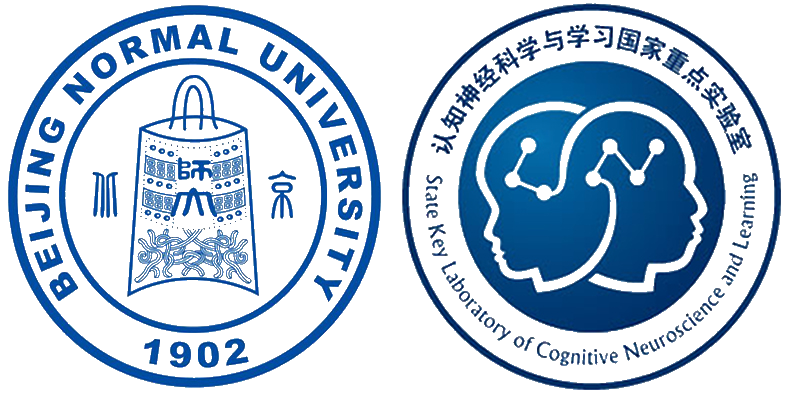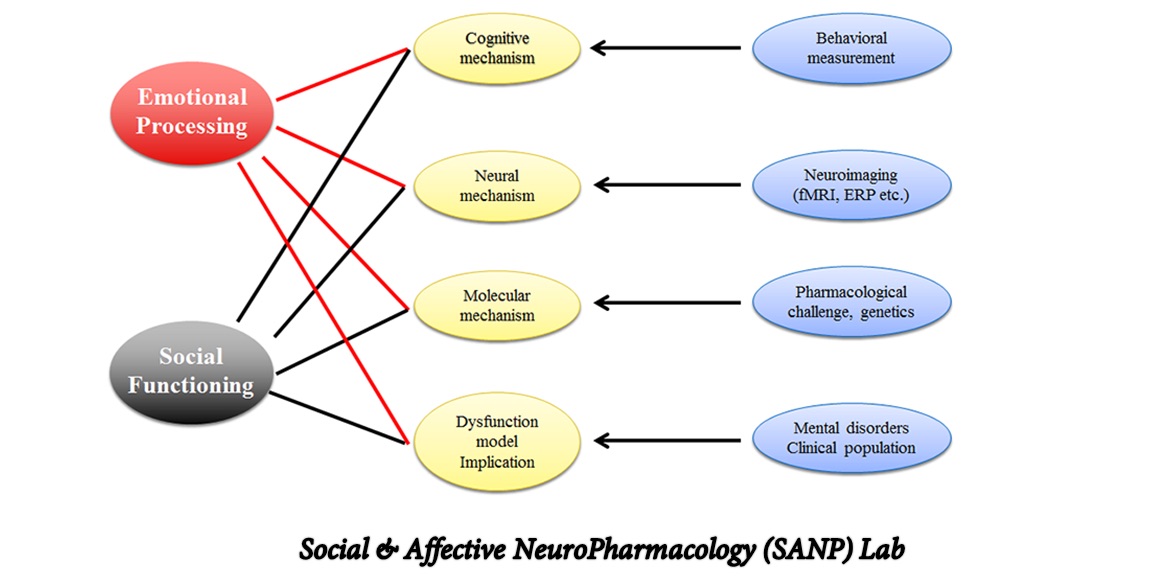
Integrating neuroscience techniques (functional MRI, EEG, fNIRI), genetics, pharmacological challenge and disorder model, the SANP Lab aims to elucidate the neurobiological mechanisms underlying social and emotional processes and to reveal how the mechanisms are altered. These findings have been published on Molecular Psychiatry, Brain, Trends in Cognitive Sciences, Cerebral Cortex, Neuropsychopharmacology, British Journal of Psychiatry, Neuroimage, Human Brain Mapping, JEP, JESP etc. The long-term goals of the SANP Lab are to uncover the central neurobiological determinants of human emotion and social cognition, and to then integrate its empirical findings with public mental health issues to promote treatment for mental disorders and wellbeing.
Serotonin and human negative emotion
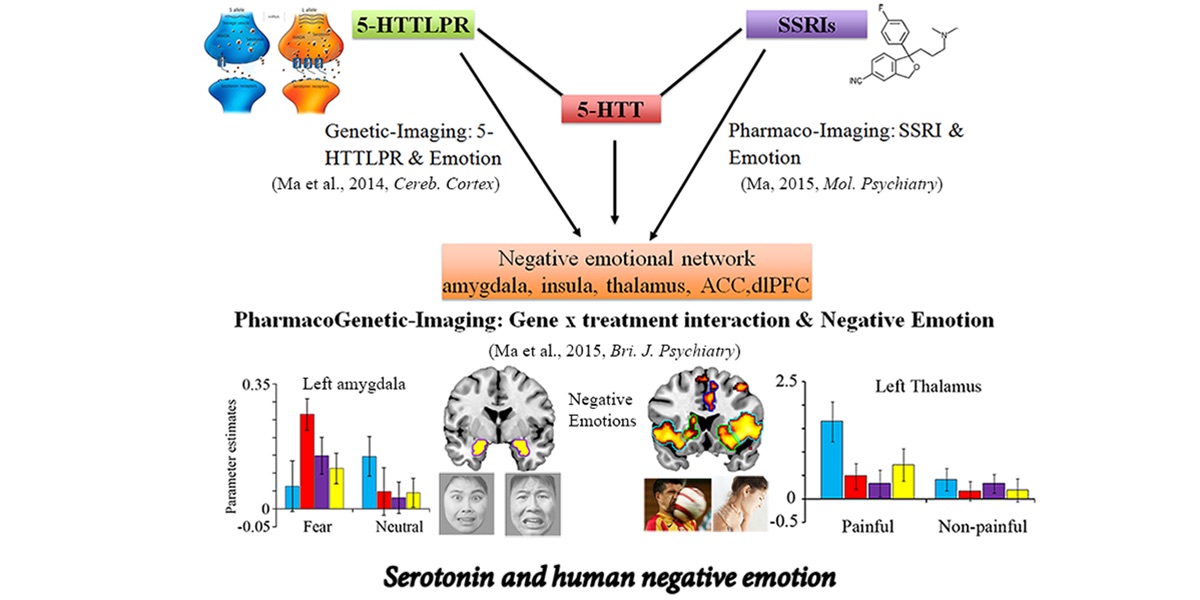
The SANP Lab examines how serotonergic genetics, pharmacology and their interaction influence brain responses to negative emotions. Combining genetic neuroimaging, pharmacological manipulation and psychological paradigms targeting emotion, we developed a new pharmacogenetic-imaging approach to address the role of serotonin transporter (5-HTT) on human emotion. We applied this pharmacogenetic-imaging approach in several empirical studies to address the role of 5-HTT on human negative emotion. Generally, we administrated serotonergic drug citalopram to short/short (s/s) and long/long (l/l) homozygotes of 5-HTTLPR during fMRI scanning of negative emotions (including fearful, pain and pain empathy). We provide the first pharmacogenetic neuroimaging evidence for a causal link between 5-HTT and 5-HTTLPR effects on human brain activity underlying emotional processing (Ma et al., 2015, Br J Psychiatry; Ma et al., under review). The type of Genotype x Treatment interaction revealed by the pharmacogenetic-imaging approach is critical for advancing drug efficacy and personalized treatment.
Oxytocin and social adaptation

Adaptation to the social environment is critical for human survival. The hypothalamic peptide oxytocin (OT) is an evolutionarily ancient neuropeptide and hormone implicated in sociality and well-being. The social adaptation model of OT function (Ma et al., 2016, Trends Cogn Sci) posits that a fundamental function of OT is to promote adaptation to the social environment, by modifying cognitive processes and emotional responses and adjusting behaviors. OT ameliorates impaired social adaptation of individuals with social deficits by normalizing hyper- or hypo-brain activity. Our social adaption model (SAM) provides an integrative understanding of discrepant OT effects and the modulations of OT action by personal milieu and context. Combining computational modeling and neuroimaging techniques, the SANP Lab aims to examine how the biological pathways activated by OT interact with different psychological, computational processes to influence human behavior.
Neural representation of the self
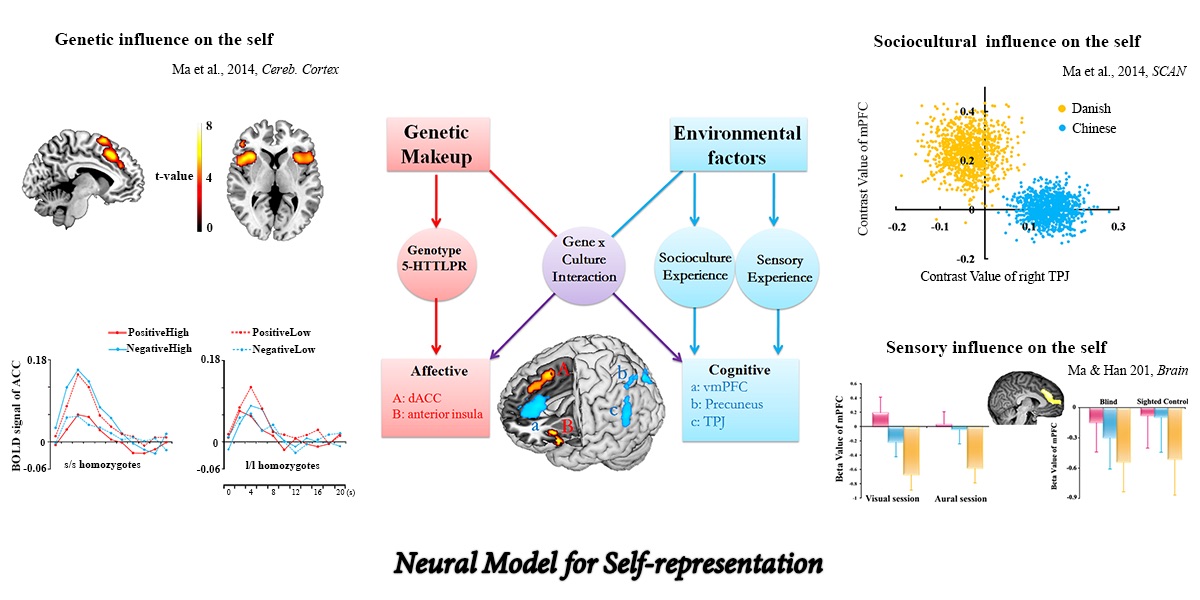
Social cognitive mechanism underlying self-face recognition
This line of research examined the cognitive and neural mechanisms involved in self-face recognition. We proposed an implicit positive association theory (the IPA Theory) to explain self-face advantage, which states that self-face recognition and the concomitant self-awareness activate positive attributes in self-concept, which then facilitates behavioral responses to self-face and results in self-advantage (Ma & Han, 2010; JEP: HPP). The IPA theory predicts that social threats to positive view of the self should slow responses to self-face (the Boss Effect, Ma & Han, 2009, JESP), and this effect should be stronger in East Asian cultures that emphasize how others perceive that self than in Western cultures that encourage independent self (Liew, Ma et al., 2011, PLoS One). Furthermore, combining fMRI, psychophysical training and face-morphing technique, I designed a study which demonstrated functional dissociations of the left and right fusiform in the representations of self-face physical properties and self-face identity, respectively (Ma & Han, 2012, Hum Brain Mapp).
Neural model for self-representation
We built up a neural model to reveal how environmental (i.e. physical sensory and sociocultural experience) and genetic factors influence the neural mechanism engaged in self-concept. In this neural model, we showed that sensory experience and sociocultural context mainly affect the cognitive component of self-representation in the media prefrontal cortex (mPFC), which encodes self-relevance of stimuli and in the temporoparietal junction (TPJ), which represents others' mind (Ma & Han, 2011, Brain; Ma et al., 2014, SCAN; Han et al., 2010, SCAN). Genetic factors, however, mainly influence the affective component of self-representation in the dorsal anterior cingulate cortex (dACC) and anterior insula (AI) that mediate negative affect associated with self-reflection (Ma et al., 2014, Cereb Cortex). Moreover, the gene-cultural interaction influences both the cognitive and affective components of the neural network involved in self-reflection (Ma et al., 2014, SCAN).
Cultural and social cognition
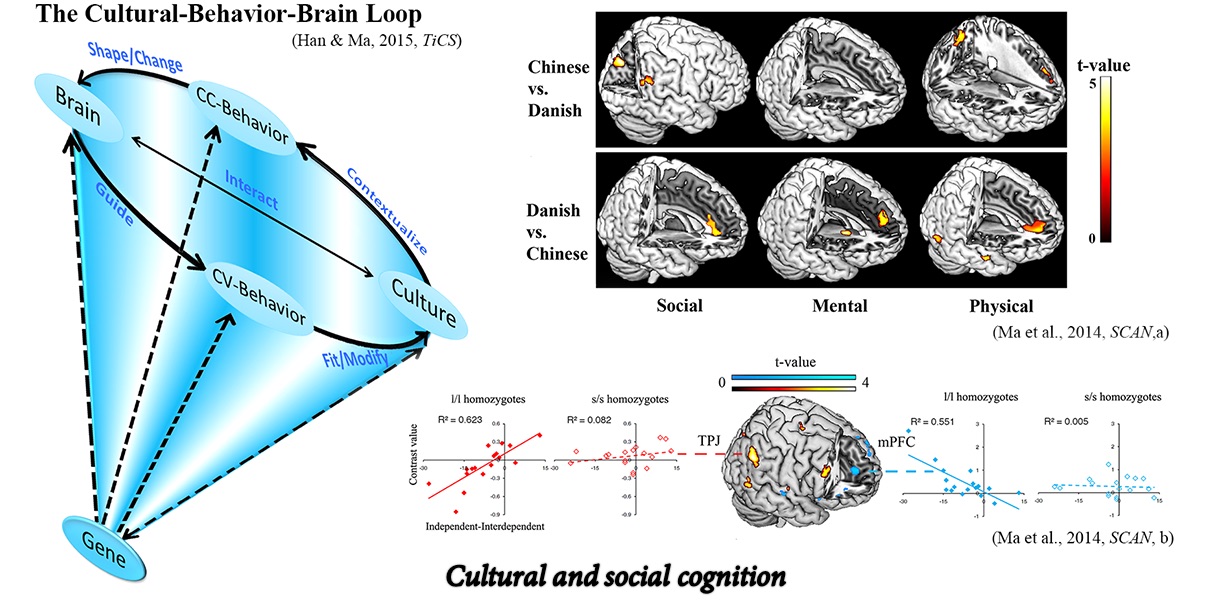
Why do people in culturally-distinct societies behave differently, have distinct cognitive and affective processes? How about the culture and gene interaction effects in shaping our behavior and brain, and what kind of relationship between the gene, behavior, brain and culture? We proposed the Culture-behavior-brain loop Model (Han & Ma, 2015, TiCS), which helps us predict the future brain changes, answer the ultimate philosophical proposition: what makes me the person I am? The SANP Lab is doing empirical studies to lend supports for this model, trying to answer how cultural experiences affect human brain at the molecular level, and what are the adaptive effects of culture on human mindand behaviors.
Neurotransmitter and emotional/social learning
Humans live in a complex, changing social environment. Adapting to the dynamic environment requires learning from feedback to accordingly update beliefs, change decisions and guide future behaviors. Different neuromodulators (such as dopamine, oxytocin and serotonin) play crucial roles in our decision-making and future prediction. The SANP Lab is interested in revealing the neurocomputational mechanisms underlying social and emotional learning and uncovering common and selective effects of different neuromodulators. When learning social feedback and update beliefs, human manifests an optimistic manner, i.e., people update desirable (better than expected) news into their beliefs but discount or ignore undesirable (worse than expected) news. Our recent work (Ma et al., in press, Proc Natl Acad Sci USA) has revealed oxytocin (OT) as an important molecular substrate underlying the formation of optimistic beliefs about the future. We have shown that intranasally administered OT augments optimistic belief updating by increasing updates and learning of desirable feedback but impairing updates of undesirable feedback. Moreover, such OT-impaired updating of undesirable feedback is evident in individuals with high but not low depression or anxiety traits. In addition, OT also increases second-order confidence judgment after receiving desirable feedback.
Shared experiment stimuli (Chinese version)
Picture stimuli for "Read mind in the eye" paradigm
All stimuli, notes, pilot rating data, and program (PTB) are available upon request (Email:yma@bnu.edu.cn)
